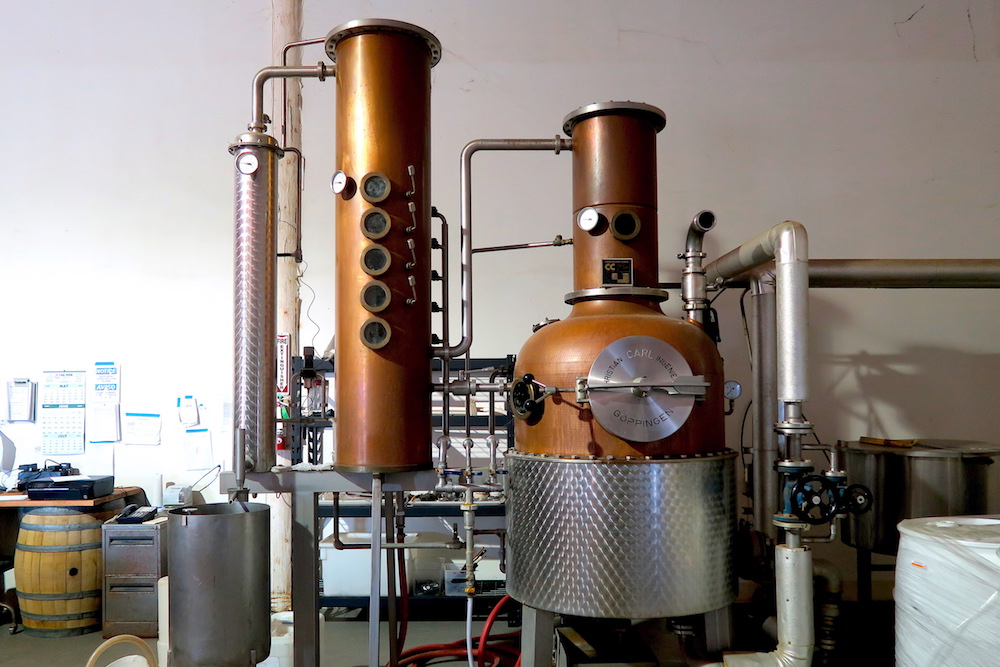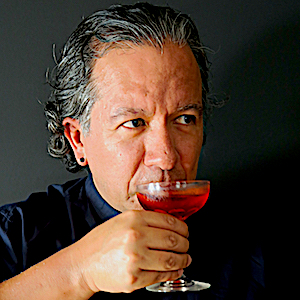California’s Pisco Trail
From California’s Gold Rush until Prohibition, San Francisco’s spirit of choice was pisco—a clear, unaged, grape brandy from Peru’s Ica Valley. Wineries and distilleries that have been making pisco there for over 400 years are connected by La Ruta del Pisco, or The Pisco Trail. Today, Marian Farms and Frísco Brandy are forging California’s Pisco Trail by making a pisco-inspired grape brandy that honors the brandy’s Peruvian roots and the spirited history of brandy in California.
The Grapes and Fire Water of Peru and California
Spain gave Peru and California a common viticultural heritage when it brought the Listán Prieto grape to the Americas in the early 1500’s. In Peru, Listán Prieto became known as Negra Criolla, while in California, Listán Prieto became known as the Mission Grape. From these grapes, vineyards and wine production flourished in the New World, making Peru the earliest wine producing region in South America.
By the early 1600’s, Peru began distilling wine to make aguardiente de uva or pisco, the oldest grape spirit of the Americas. A century later, Franciscan missionaries and winemakers produced California’s first brandy, aguardiente de vino. The earliest aguardiente spirit, however, dates back to the Middle Ages, when alchemists distilled an aqua ardens, or fire water, for medicinal purposes. Since the tradition of barrel-aging brandy came later, aguardiente was a clear, unaged, spirit.
The Golden Age of Pisco and Brandy in California
NavigatorJuan Francisco de la Bodega y Cuadra introduced pisco to San Francisco during his expeditions from the Viceroyalty of Peru to California in the late 1700’s. During the Gold Rush, Pacific trade routes also brought pisco from Peru to California and gave birth to San Francisco’s legendary Pisco Punch cocktail. Through the 1800’s, brandy production boomed along the West Coast. One California winemaker and tycoon, Leland Stanford, became the world’s largest producer of a European style barrel-aged brandy.
Despite their popularity, pisco and brandy disappeared from California with the start of Prohibition in 1920. It wasn’t until after World War II that distillers in California resumed producing barrel-aged brandy, which had an amber color and oak flavor from the wood casks. Now, there is a new wave of brandy producers in the state. And California’s Pisco Trail begins in the Central Valley, with producers Marian Farms and Frísco Brandy.
A Third-Generation Farmer Makes a California Style Pisco
The agricultural heart of California is the Central Valley. Bounded by the Pacific coastal ranges in the west and the Sierra Nevada mountains in the east, it stretches north to south from Redding, and through Fresno to Bakersfield. This region, known for its viticulture, is the home of Marian Farms, where third generation farmer and winemaker Gena Nonini has been distilling grape brandy for the past decade. Making brandy begins with tending to the vineyards in her pioneering biodynamic farm.
“I am a farmer first, and distiller second,” she explains. Marian Farms is the first U.S. vineyard and distillery to be certified biodynamic. Because they follow organic practices, they don’t use pesticides. Instead, they pull out weeds by hand. The land here is ideal for growing grapes. The sandy loam soil is similar to Peru’s Ica Valley, which is also at the foothills of a mountain range, the Andes. In Fresno’s dry summer, Marian Farms uses water from the mountains to flood the vineyards, just like in Peru.
Nonini blends two white grape varietals for her brandy, Muscat of Alexandria and Palomino Fino. Muscat of Alexandria, an ancient vine with likely origins in North Africa, is one of the parents of the Negra Criolla, a pisco grape varietal in Peru. Palomino Fino, native to Spain’s Andalucía region, is popular for producing sherry, a fortified wine.
Nonini’s autodidact approach to distilling is hyperlocal and sustainable. “We only distill what we grow,” she says. Nonini uses a modern hybrid still, a steam-heated copper pot with a column, to distill the spirit twice. The result is a clean, clear, high-proof spirit which she dilutes with water and rests in stainless steel tanks before bottling at 40% ABV.
With terroir similar to Peru, it’s not surprising that in 2014, Wine & Spirits magazine described Marian Farm’s California brandy as a clean, versatile, and sippable pisco, “with dark fruit aromas, and a slightly sweet violet flavor.” In fact, the original label read, “California Style Pisco,” for which they received a 2012 Good Food Awards in the Spirits category. But because both Peru and Chile claim rights to the term “pisco,” the label stirred controversy. The Alcohol and Tobacco Tax and Trade Bureau forced Nonini to change the name. Now it’s called Pisquita, a nod to the earthen jars used to store pisco centuries ago.
The soil at Marian Farms.
Pisquita and Frísco Brandy.
Modern hybrid pot still at Marian Farms.
A New Model for Making Pisco-Inspired Brandy
Like Marian Farms, Frísco Brandy uses Muscat of Alexandria grapes from the Central Valley, but its approach to producing a pisco-inspired brandy is different. Instead of investing in a brick and mortar facility, they source grapes from a sustainable vineyard, and hire expert California distillers to make the brandy according to a formula. Frísco founder Charlie O’Connell implemented this model to reduce costs and make the product affordable and accessible.
The inspiration to make brandy came from O’Connell’s time spent studying abroad in Chile and Peru, where imbibing pisco was de rigueur. After enjoying the South American spirit with “an emotion of exploration and wonder,” he tried to import it to the US. But doing so proved too challenging and costly. A chance meeting with a cousin who studied winemaking in California led to a fruitful collaboration.
After patiently experimenting with different grape varietals and water sources, the recipe for Frísco Brandy was born. O’Connell’s cousin also traveled to Peru to learn more about pisco production. Frísco’s double distillation process yields a high proof clear spirit which Frísco dilutes with water from Ukiah before bottling at 45% ABV. The end result is a spirit with “vibrant tropical notes that evoke flavors of the grape along with papaya and pineapple,” says O’Connell.
Although Frísco has produced its brandy for less than three years, it won Gold at the 2018 Los Angeles International Spirits competition. Like Nonini before him, O’Connell realized he couldn’t call his brandy “pisco.” He settled on Frísco, a play on pisco and San Francisco, and an homage to the historical connection between Peru and California.
Is it Aguardiente, Pisco, or Brandy?
The first grape distillates in Spain, Peru, and California, were all known as aguardiente, which later became pisco in Peru and brandy in California. But for many, to be called pisco, it must be made in Peru. There, pisco is produced following a strict denomination of origin controlled process (DOC) which only allows eight grape varietals, grown in designated areas, such as Peru’s Ica Valley.
According to DOC regulations, when pisco is made with only one grape varietal, it’s a puro, or pure pisco. When its blended, it’s an acholado. Pisco grapes are also classified as either aromatic or non-aromatic, and a blend usually has both. Though several pisco grape varietals have origins in the Old World, one is native to Peru—Quebranta, a cross between the Negra Criolla and Mollar, both originally from Spain.
Walter Moore, co-founder of San Francisco based Encanto Pisco, began producing pisco in Peru’s Ica Valley in 2009. In Peru, he became intimately familiar with pisco’s production, terroir, and flavor characteristics. Moore, who has a background as a sommelier, tasted Marian Farms’ Pisquita and Frísco Brandy in order to provide notes on the spirits and a comparison of their grape varietals.
Moore describes Pisquita as “full bodied, soft and clean, with bright spearmint and dark licorice dominating the palate.” He adds, “the high toned delicate dry finish makes this nice for sipping but would work well in spirituous cocktails.” The dominant mint and licorice reminded him more of Quebranta than Muscat, which is typically associated with the aromas of white flowers and orange oil. And because Marian Farms blends their brandy, it resembles an acholado style, or blended pisco.
Moore describes Frísco Brandy as “medium bodied with an oily satiny mouthfeel, the attractive root beer cola-like nose turns to olives and chocolate on the palate.” He adds, “the long dry finish is high toned and will stand up very well to more fruit-driven or aromatic heavy cocktails.” The darker notes in Frísco Brandy also reminded him more of Quebranta than Muscat. And because Frísco uses a single grape varietal in their brandy, it resembles a pisco puro, or pure pisco.
Moore explained that despite some overlap in the grape varietals used to make pisco in Peru and Chile, there are significant differences in the production process. In Peru, the process has remained largely unchanged for centuries—producers heat traditional copper pot alembic stills over a direct source, such as a wood fire, and distill the spirit only once to proof without adding water or aging the spirit in a cask. In Chile, however, it’s distilled twice, producers add water to dilute the spirit, and may also age the brandy. Since Marian Farms and Frísco Brandy both use double distillation and add water, their process is more similar to the production process found in Chile; however, they follow the Peruvian tradition of not barrel-aging the brandy.
Despite modern techniques, Marian Farms and Frísco Brandy distill spirits with strong connections to the past. The big challenge for both California producers is to gain acceptance and break into the brandy category. What they are facing is centuries of tradition and established producers from Europe, North America, Peru, and Chile. But if these California producers can break in, they might make a pisco-inspired brandy San Francisco’s spirit of choice once again.
Born in Peru and based in San Francisco, Nico Vera is a freelance writer, mixologist, chef, and photographer specializing in Peru’s drink and food culture around the world. He has written and done photography for Imbibe, Eaten, and New Worlder. He also loves running on mountain trails to connect with Pachamama.







